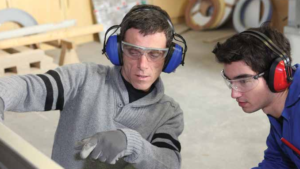
In today’s job market, workers need every advantage they can get to stay ahead of the competition. In Albuquerque N.M., they’ve found a way for sheet metal apprentices to gain that advantage, while simultaneously giving back to the community.
How? The JATC for SMART Local 49 has partnered with the Greater Albuquerque Habitat for Humanity.
“Working with Habitat provides our apprentices phenomenal experience,” explains John Pennebaker, full-time instructor with Local 49. “Approximately 86 apprentices worked on the first three houses combined,” says Jerry Arms, co-ordinator at the New Mexico and West Texas training center. “The experience in real-world problem solving has allowed them to gain experience not otherwise found at the training center.”
Industry contributions in the project included $700 in materials. Learning to plan ahead benefits extend beyond experience, however. Building in the real world also saves materials that would otherwise have been discarded.
“Our students traditionally build small-scale in the classroom,” says Pennebaker. Often, once graded, the small-scale projects were dismantled, with materials discarded. The Habitat partnership enables apprentices to build – full size – and install the finished project in a home. No significant discards.
“It teaches them value. It forces them to plan ahead and think through the entire job,” Arms says. “It also gets them into the residential market, which is important because few of the guys have previously been exposed to it. Most are more aware of the commercial market.”
Aside from enhancing his students’ education, Pennebaker believes it is important to make contributions to the community. “A person should not just have a job; he or she should be a person of value to the community. Part of achieving that is volunteer work,” he says.
Apprenticeship is a serious undertaking, but this slice of the curriculum in Albuquerque brought smiles to the students, Arms notes. “It’s been a really good experience. All the apprentices seemed like they really enjoyed it. A few have volunteered with Habitat for Humanity on their own time as a result.”
Pennebaker contends that the effort benefits more than just Habitat for Humanity and the students—it does good things for the industry in general: “Contributing to the community through our partnership with Habitat for Humanity gives union a better light in which to shine.”
On the Habitat end, there are smiles, too, according to Judy Lucero, executive director for the Greater Albuquerque Habitat for Humanity. “The bulk of our volunteers are not skilled,” she says. “To have a group like this, it’s definitely a win-win for all of us. We would really be handicapped without it.”
“What’s more,” she adds, “with apprentices at work the job goes so much faster. Typically, it takes 12 weeks to build a 1,100-square-foot home from start to finish. When we have groups like this involved, it cuts our build time by a couple weeks, saving money and keeping our program going forward.” “As an added bonus,” Lucero remarks, “it really is a training, on-site classroom for apprentices.”



